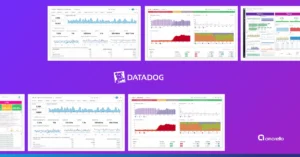
Reading time: 6 minutes
Recently, we have witnessed a new wave of memes, alluding to the continuous increase in temperature, the ravages of heat waves, followed by torrential rains, have made their greatest impact on the national territory of Mexico.
However, it is important to remember and recognize that this is a global problem that is having a devastating effect on the entire world. It is for this reason that one of the main objectives in the United Nations (UN) Agenda 2023 for sustainable development is to try to reduce the carbon footprint produced by CO₂ emissions.
This has motivated many governments, companies and suppliers to take measures to reduce the environmental impact of their activities.

Unfortunately, the increasing use of technology, especially information technology, has a major impact on the environment. According to a study by Lancaster University in the United Kingdom, the use of ICTs accounts for between 2% and 4% of the planet’s CO₂ emissions; according to data from Interempresas’ Sustainable IT Report , data centers consume 3.5% of the world’s energy.
You may be interested in: eCommerce Search Engine: Boost your business profitability
Everything seems to point to the use of technology, especially ICTs, as an environmental problem, so digitalization must also contribute to the solution, helping to reduce the carbon footprint, achieve more efficient energy consumption, and establish the guidelines for a sustainable infrastructure that allows the implementation of technology in a sustainable way.
Green IT the solution?
So far the outlook looks bleak, however, as already mentioned, if technology contributes to the carbon footprint, it can also be part of the solution and promote sustainability, let’s talk about sustainable technology or Green IT.
As you probably already know or imagine, sustainable technology, also known as green technology or Green IT, refers to the implementation and use of technology, in such a way that it can perform its function, minimizing its environmental impact, without producing harmful impacts, wear and tear or pollutants, and using renewable energy sources that are environmentally friendly.

Green technology focuses on the sustainable development of technological alternatives that contribute multiple benefits to society, the environment and future generations. Some current examples of sustainable technology are:
You may be interested in: Big Data in the cloud: What stage is your company at?
AI or Artificial Intelligence: Protagonist of multiple controversies, AI has also allowed the automation of multiple tasks, as well as the simplification of activities and even the optimization in the use of available resources, thus increasing productivity and efficiency in the consumption of resources.
Solar cells: They allow the training, storage and use of solar energy, thus substituting the use of other types of energy, primarily electricity, reducing costs for multiple companies, as well as avoiding the overloading and use of hydroelectric power plants.
Electronic signature: Avoids the unnecessary use of paper, in addition to speeding up transactions, thus reducing the production of garbage, as well as avoiding the cutting down of trees.
Cloud Computing: Of course we cannot leave out the cloud, one of the most sought-after sustainable technologies, thanks to its enormous number of ecological and economic advantages, since it allows remote storage on external servers.
See also: Data migration through BigQuery and Google Cloud.
The use of Cloud Computing allows to considerably reduce CO₂ emotions, as well as the costs of maintaining a data center, since several clients share the same technical infrastructure, which reduces maintenance costs, as well as greater efficiency in energy consumption.
In other words, the cloud helps reduce the carbon footprint and can become a key element in the fight against climate change.
The cloud, a push towards a green future.
Sensitivity towards the importance of maintaining a sustainable operation has grown by leaps and bounds, whether due to genuine concern about the environmental crisis, the care of the brand image in the face of an increasingly critical consumer in search of environmentally friendly alternatives, or due to the search to save operating costs.
You may like: Machine Learning: Future and pillar of online stores?
According to data from the Deloitte 2022 CxO Sustainability Report, more than 90% of companies have already increased their investments in sustainability programs. However, on many occasions, companies face multiple challenges that prevent organizations from achieving their objectives in this area, this same report highlights five main obstacles that prevent the achievement of these objectives, which are:
- Difficulty in measuring environmental impact.
- Inadequacy in the supply of services.
- Primary focus on short-term commercial issues, and compliance with investor and shareholder demands.
- Changes too large.
- Excessive costs.
This conflict can be solved thanks to Cloud technology, which strengthens as an eco-friendly alternative, facilitating the transition towards an eco-sustainable digitalization, by providing tools that allow to efficiently address the main obstacles faced by organizations.

Now go: How to bring value to my business through Data Analytics?
The main cloud providers have taken note and are concerned about meeting the requirements of their current and potential customers, as well as their commitment to improve the efficiency of their services to add their participation in the fulfillment of the 2030 Agenda for sustainable development. They offer organizations alternatives that allow an intuitive and efficient eco-digital transition such as:
- Sustainability calculators
Through multiple tools, they allow to measure the impact and reduce the carbon footprint of the infrastructure. - AI & Data Analytics
Thanks to their combined functionality, it is possible to identify areas for optimization and improvement throughout the value chain, allowing for better, more efficient and productive process management. - FinOps
Identifying areas for optimization is only part of the process, implementing the cloud also enables better cost control, allowing for more efficient budget allocation, as well as identifying savings opportunities without affecting business objectives. - Ecosystem innovation Leveraging infrastructure innovation allows for more seamless integration with other sustainable digital ecosystems, streamlining operations and significantly reducing costs.
- New operating models
It is also possible to renew operating processes, automating and optimizing processes, in addition to fostering a better organizational and operational culture through DevOps and AIOps.
To this we must add the benefits of the cloud as a sustainable technology, such as:
Reduction of CO₂ emission
Migration and use of the cloud can reduce up to 84% of carbon emissions to the environment, related to the IT infrastructure of companies, by reducing the use of infrastructure and own devices.
Decreases the use of hardware
Migrating to the cloud allows centralizing and managing data in one place, which makes applications and other files lighter, significantly reducing the use of hardware and therefore energy consumption.
See also: Cloud Migration Project: What to Consider
Thus fulfilling one of the most relevant objectives of sustainable technology, which is energy efficiency.
Reduction in the number of servers
Since the hardware becomes virtual, the number of servers is reduced, which results in greater energy savings, as well as improved operation of ICT companies.
Reduce costs
Cost reduction through the use of the cloud is considerable, in addition to contributing to sustainable practices, this is one of the main reasons why cloud services are in high demand.
By reducing the use of machines and the need for specialized infrastructure, the investment in equipment acquisition and maintenance is reduced. Likewise, the costs of electricity consumption are reduced, as well as the costs of application and software updates and maintenance, since these are absorbed by the cloud provider.
You may be interested in: Google Data Warehouse use case examples
Which means an increase in productivity with significant cost reduction.
Energy saving design
The cloud also allows to strategically create policies and a customized service that promotes energy savings according to customer and environmental requirements.

- In fact, sustainable software engineering practices can reduce energy consumption by up to 50 times if they choose the right programming language for the task.
- In addition to all this, there are the operational advantages of the cloud, such as scalability in data storage, greater security in data protection and privacy, flexibility to allow remote work, agility and speed in processes.
- Google Cloud & Amarello, The perfect combination for a sustainable innovation
- You already know the main benefits of the cloud on the road to eco-sustainable digital transformation, however, true to its reputation Google Cloud, seeks to go a step beyond the competition and offer innovative solutions with greater added value for its consumers and the world in general.
- Google Cloud’s main sustainability objective is to offer the cleanest cloud in the industry by decarbonizing its data center power supply, thus taking a fundamental step in the quest for a carbon-free future.
- Check now: Know the 7 V’s of Big Data
- Under this approach, in 2017 Google Cloud managed to neutralize its CO₂ emission by using 100% electric and renewable energy; likewise, since 2021 Google Cloud managed to position itself as the cleanest cloud in the entire industry.
- Of course, this is in terms of sustainable practices, but going back to the main challenges that organizations face to achieve a more sustainable operation, Google Cloud also remains at the forefront by facilitating migration to the cloud in a simple, intuitive and effective way.
- First, it allows you to measure your environmental impact through the percentage of carbon-free energy (CFE).
- It also has a whole ecosystem of cloud services, which work more efficiently when working with applications and services belonging to Google Cloud Paltform, as well as the native use of the Google cloud, but also allow efficient operation when combined with other cloud providers and services. This allows organizations greater freedom in choosing the option that best fits their requirements.
- However, GCP also relies on specialized partners such as Amarello to identify the unique needs of each organization and develop a customized strategy to meet your requirements with the best cost-benefit offer to plan and reduce the costs and time of migration to the cloud.
- Read now: How to bring value to my company through Data Analytics?
- This, in addition to offering a smoother, faster and more efficient transition, also allows organizations to stay focused on their business strategy and meet the demands and requirements of their investors and shareholders.
- Google Cloud is also characterized by being a friendly and intuitive environment that involves minimal changes and a lower learning curve with respect to its competition, allowing hybrid migration and links with most of the tools commonly used in the sector, IT & Retail, which allows to obtain all the advantages of the cloud, minimizing the obstacles, this also translates into more satisfied and efficient employees.
- In addition, relying on the advice of an expert partner such as Amarello also means a reduction in investment costs and a higher return on investment, which translates into obtaining a 360° comprehensive solution that addresses all issues while presenting valuable benefits to achieve an evolution towards Industry 4.0; in addition to allowing organizations and businesses the ability to continue adapting continuously, anticipating the demands of the future.



